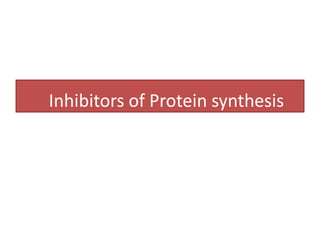
Inhibitors of protein synthesis.pptx
- 1. Inhibitors of Protein synthesis
- 2. Protein synthesis - Recap
- 3. Formation of the Initiation Complex
- 4. Joining of 50S Ribosomal Subunit
- 9. Aminoglycosides • Streptomycin – 1944 • Actinomycetes – Streptomyces griseus • Bactericidal antibiotics • Interfere with protein synthesis • Used to treat aerobic Gram –ve bacteria • Resemble each other in MOA, pharmacokinetic therapeutic and toxic properties • Relatively low margin of safety • Exhibit ototoxicity and nephrotoxicity
- 10. Aminoglycosides • Systemic – Streptomycin – Gentamicin – Kanamycin – Amikacin – Sisomicin – Tobramycin – Netilimicin • Topical – Neomycin – Framycetin
- 11. Mechanism of action • Initially they penetrate bacterial cell wall, to reach periplasmic space through porin channels (passive diffusion) • Further transport across cytoplasmic membrane takes place by active transport by proton pump; an oxygen- dependent process
- 12. Mechanism of Action • • • Bind 30S ribosomal subunits and interfere the initiation complex Induce misreading of genetic code on mRNA Breakup of polysomes into monosomes
- 13. Chloramphenicol • An antibiotic produced by Streptomyces venezuelae, an organism first isolated in 1947 from a soil sample collected in Venezuela.
- 14. Mechanism of Action • • Chloramphenicol inhibits protein synthesis in bacteria and, to a lesser extent, in eukaryotic cells. The drug readily penetrates bacterial cells, probably by facilitated diffusion. Chloramphenicol acts primarily by binding reversibly to the 50 S ribosomal subunit. Although binding of tRNA at the codon recognition site on the 30 S ribosomal subunit is thus undisturbed, the drug appears to prevent the binding of the amino-acid-containing end of the aminoacyl tRNA to the acceptor site on the 50 S ribosomal subunit. The interaction between peptidyltransferase and its amino acid substrate cannot occur, and peptide bond formation is inhibited
- 16. • Chloramphenicol also can inhibit mitochondrial protein synthesis in mammalian cells, perhaps because mitochondrial ribosomes resemble bacterial ribosomes (both are 70 S) more than they do the 80 S cytoplasmic ribosomes of mammalian cells.
- 17. Tetracycline
- 18. INTRODUCTION •Tetracyclines is a group of antibotic that include tetracycline. •Tetracyclines are obtained by fermentation from Streptomyces spp. Or by chemical transformation of natural products. • They are derivatives of an octahydro- naphthacene,a hydrocarbon system that comprises four annulated six member rings. • • •
- 19. Mechanism of Action • Tetracyclines are specific inhibitors of bacterial protein synthesis. They bind to the 30S ribosomal subunit and thereby prevent the binding of aminoacyl tRNA to the mRNA ribosome complex. • Tetracyclines also inhibit protein synthesis in the host ,but are less likely to reach the concentration required because eukaryotic cells do not have a tetracycline uptake mechanism.
- 20. Macrolides
- 21. • Inhibits protein synthesis by reversibly binding to the 50S ribosomal subunit – Suppression of RNA-dependent protein synthesis by inhibition of translocation of mRNA • Typically bacteriostatic activity • Bactericidal at high concentrations against very susceptible organisms
